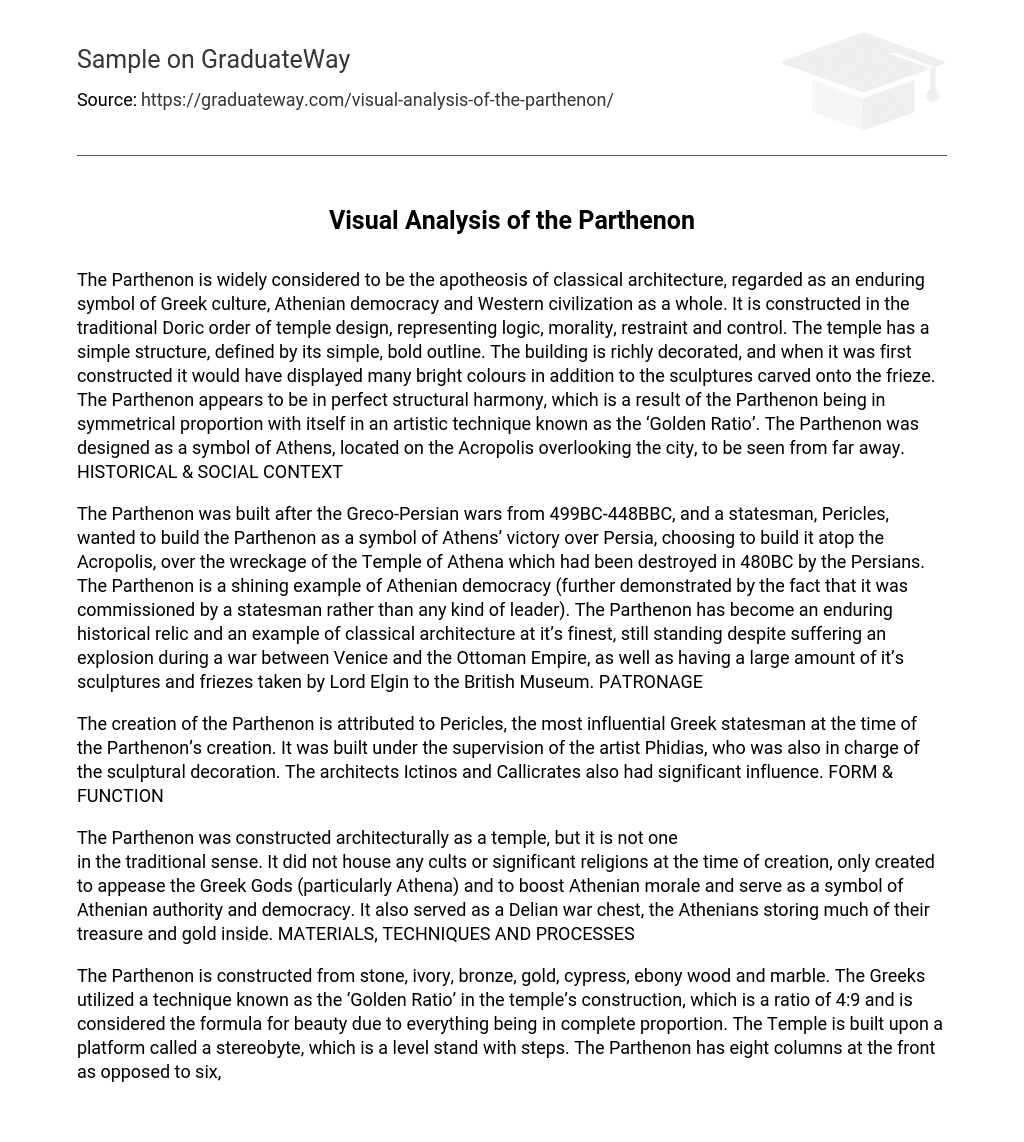The Parthenon is widely considered to be the apotheosis of classical architecture, regarded as an enduring symbol of Greek culture, Athenian democracy and Western civilization as a whole. It is constructed in the traditional Doric order of temple design, representing logic, morality, restraint and control. The temple has a simple structure, defined by its simple, bold outline. The building is richly decorated, and when it was first constructed it would have displayed many bright colours in addition to the sculptures carved onto the frieze. The Parthenon appears to be in perfect structural harmony, which is a result of the Parthenon being in symmetrical proportion with itself in an artistic technique known as the ‘Golden Ratio’. The Parthenon was designed as a symbol of Athens, located on the Acropolis overlooking the city, to be seen from far away. HISTORICAL & SOCIAL CONTEXT
The Parthenon was built after the Greco-Persian wars from 499BC-448BBC, and a statesman, Pericles, wanted to build the Parthenon as a symbol of Athens’ victory over Persia, choosing to build it atop the Acropolis, over the wreckage of the Temple of Athena which had been destroyed in 480BC by the Persians. The Parthenon is a shining example of Athenian democracy (further demonstrated by the fact that it was commissioned by a statesman rather than any kind of leader). The Parthenon has become an enduring historical relic and an example of classical architecture at it’s finest, still standing despite suffering an explosion during a war between Venice and the Ottoman Empire, as well as having a large amount of it’s sculptures and friezes taken by Lord Elgin to the British Museum. PATRONAGE
The creation of the Parthenon is attributed to Pericles, the most influential Greek statesman at the time of the Parthenon’s creation. It was built under the supervision of the artist Phidias, who was also in charge of the sculptural decoration. The architects Ictinos and Callicrates also had significant influence. FORM & FUNCTION
The Parthenon was constructed architecturally as a temple, but it is not one
in the traditional sense. It did not house any cults or significant religions at the time of creation, only created to appease the Greek Gods (particularly Athena) and to boost Athenian morale and serve as a symbol of Athenian authority and democracy. It also served as a Delian war chest, the Athenians storing much of their treasure and gold inside. MATERIALS, TECHNIQUES AND PROCESSES
The Parthenon is constructed from stone, ivory, bronze, gold, cypress, ebony wood and marble. The Greeks utilized a technique known as the ‘Golden Ratio’ in the temple’s construction, which is a ratio of 4:9 and is considered the formula for beauty due to everything being in complete proportion. The Temple is built upon a platform called a stereobyte, which is a level stand with steps. The Parthenon has eight columns at the front as opposed to six, and the columns are in the Doric order with fluting. The Parthenon has the appearance of being perfectly spaced and linear, but is actually a well crafted optical illusion; the columns and stylobates bulge or slant slightly in order to give the appearance of perfect verticality via the principle of entasis, designed to appeal to how the human eye perceives them. GENDER, NATIONALITY AND ETHNICITY





